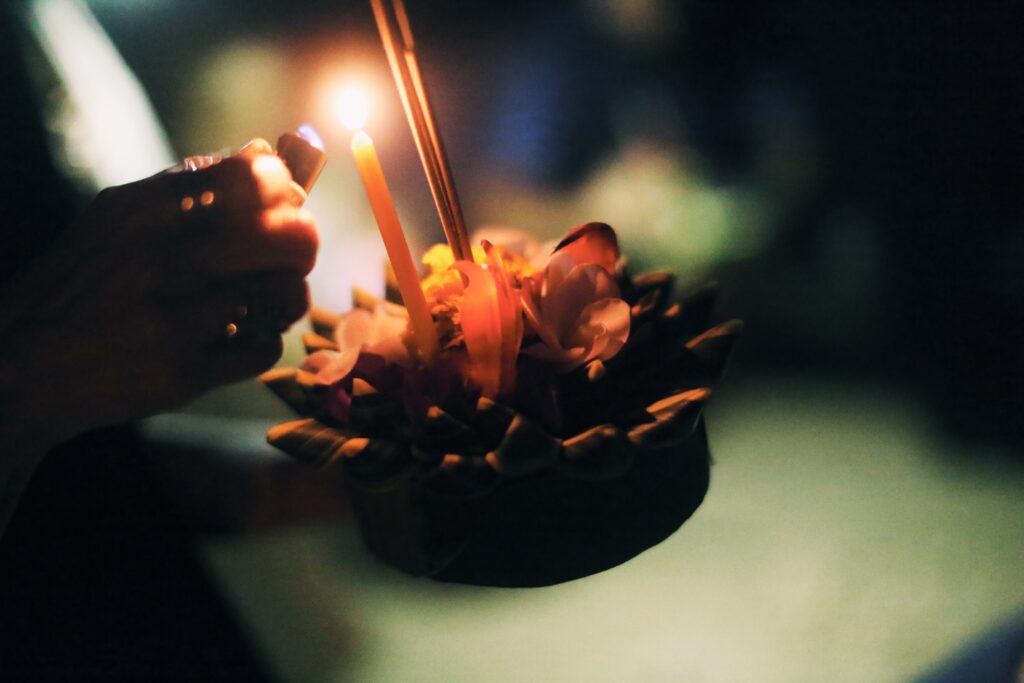Loy Krathong in Thailand:
The Festival of Lights and Renewal
Amidst the colorful tapestry of Thailand’s festivals, Loy Krathong stands out as a mesmerizing celebration of lights, water, and renewal. Held annually on the full moon night of the twelfth lunar month (usually in November), this enchanting festival is a testament to the deep spiritual connection between the Thai people and their environment. Loy Krathong captures the essence of gratitude, letting go of negativity, and embracing the promise of new beginnings.
The Festival of Lights
Loy Krathong, often referred to as the “Festival of Lights,” is celebrated across Thailand with joy and enthusiasm. The highlight of the festival is the floating of krathongs – small, elaborately decorated rafts traditionally made from banana leaves, flowers, candles, and incense. These intricate krathongs symbolize releasing negativity and offering respect to the water spirits, thanking them for their life-sustaining role.
Roots and Historical Significance
Loy Krathong has deep historical and cultural roots in Thailand. It is believed to have originated in the ancient Sukhothai kingdom, during the reign of King Ramkhamhaeng. The festival’s spiritual significance is attributed to Brahmanic and animistic beliefs, as well as the influence of Thai folklore. Loy Krathong is closely tied to the practice of Buddhism and the belief in karma, as the act of releasing the krathong is seen as a way to let go of bad luck and negativity from the past year.
Symbolism and Importance
Renewal and Letting Go: The act of setting the krathong afloat symbolizes releasing negative emotions, grudges, and worries. As the krathong drifts away, it is believed that the negative energies also depart, clearing the path for renewal and positive changes.
Gratitude to Water: Water holds immense importance in Thai culture, as the country is dotted with rivers, canals, and lakes. Loy Krathong serves as a way to express gratitude to the water spirits, seeking forgiveness for any harm caused to water bodies and acknowledging their vital role in sustaining life.
Spiritual Cleansing: Loy Krathong is considered a form of spiritual cleansing, providing individuals with an opportunity to purify their souls and seek blessings for the upcoming year.
Community Bonding: The festival brings communities together, fostering a sense of unity and togetherness. People gather by rivers, lakes, and other water bodies to release their krathongs, sharing in the collective experience.
Cultural Heritage: Loy Krathong is a beautiful example of Thailand’s cultural heritage. By continuing this tradition, the Thai people honor their ancestors and preserve the spiritual practices that have shaped their society for generations.
Modern Adaptations
While rooted in tradition, Loy Krathong has evolved with time. Today, in addition to the traditional banana leaf krathongs, you’ll find krathongs made from various materials, including bread, ice, and even environmentally friendly alternatives. The festival has also become a tourist attraction, allowing visitors to experience the magic of Thai culture firsthand.
Loy Krathong
Loy Krathong is more than just a festival; it’s a spiritual journey that connects the Thai people with their cultural heritage, their environment, and their inner selves. As candlelit krathongs gently float on the water’s surface, they illuminate the hopes and dreams of the Thai people, creating a breathtaking spectacle that resonates with the human spirit’s innate desire for renewal and connection. Loy Krathong reminds us all of the importance of letting go, expressing gratitude, and embracing the promise of new beginnings – values that transcend borders and cultures, making this festival a truly universal celebration of life and light.

